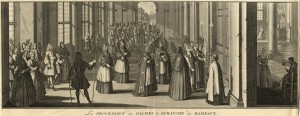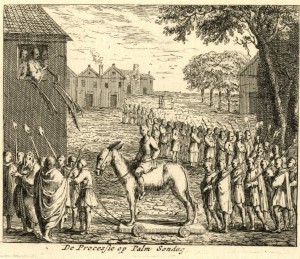Douce was very interested in religious ceremonies and devotional practices and hence he gathered a remarkable number of prints on this subject. However, the only depictions of Easter parades that I have found among his prints are images of Palm Sunday processions. The print below, cut from Jean Frederic Bernard’s Cérémonies et coutumes religieuses de tous les peuples du monde (1723-1743), shows an unusually child-free (and donkey-free) Palm Sunday parade:

Bernard Picart, La Procession des Palmes le Dimanche des Rameaux, c. 1723, engraving (Ashmolean Museum, Oxford)
As you can see, the cloaks worn by the participants are embroidered with skulls and the pervading mood is rather gloomy. The text accompanying this image focuses on Palm Sunday celebrations in the Vatican, which might explain the extreme seriousness of the procedures. The Dutch etching below, also from Douce’s collection, is more like the Palm Sunday parades I am familiar with:
The print was published as an illustration to Isaac Le Long’s Historische Beschrijving van de Reformatie der Stadt Amsterdam (Amsterdam, 1729), a few pages of which were kept by Douce in the same folder, which does not contain any other images. The Dutch etching is more or less contemporary with the engraving by Picart, but it shows a completely different way of staging the same religious event. The pomp and circumstance of the Vatican contrast with the simplicity of the outfits and props used in the procession outside a Dutch town -with the exception of the wonderful donkey on wheels, which could be exactly what the ‘donkey parade’ in Hamble, near Southampton, needs:
Palm Sunday in Hamble, near Southampton

